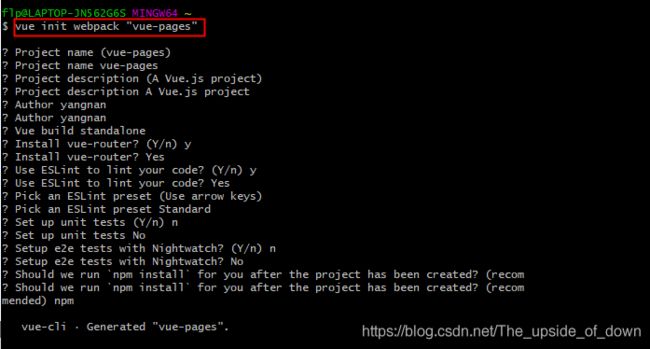vue-cli+webpack搭建一个多页面应用
vue-cli+webpack搭建一个多页面应用
- 什么是单页面应用和多页面应用?
-
- 单页面和多页面的区别
- 如何使用vue-cli+webpack初始化一个项目?
- vue-cli+webpack搭建多页面应用
-
- 项目结构调整
- webpack配置更改
什么是单页面应用和多页面应用?
SPA单页面应用:指的是只有一个主页面的应用(只有一个html页面),项目启动时加载主页面时会一次性加载所有的js、css等相关资源(需要进行首屏优化)。所有内容都包含在主页面中,对每一个功能模块组件化。单页面的跳转实质上就是切换相关组件,仅仅刷新局部资源。
MPA多页面应用:指的是有多个独立的页面(多个HTML页面),打开不同的页面时会加载相关的js以及css资源,公共资源会重复加载。多页面应用跳转,需要整个页面进行刷新。
单页面和多页面的区别
1、刷新方式
- SPA:相关组件的切换,页面局部刷新;
- MPA:整个页面进行刷新。
2、路由模式
- SPA:可以使用hash,也可以使用history;
- MPA:普通链接跳转。
3、用户体验
- SPA:页面片段间切换快,用户体验效果好,但初次加载文件过多,需要做相关优化;
- MPA:页面切换缓慢,流畅度不够,用户体验效果较差;
4、数据传递
- SPA:容易实现数据传递(路由带参数传值、Vuex传值等);
- MPA:依赖url传值、cookie、本地session。
5、使用范围
- SPA:高要求的体验度,追求界面流畅的应用;
- MPA:适用于追求高度支持搜索引擎的应用。
如何使用vue-cli+webpack初始化一个项目?
1、使用vue init webpack "项目名"

2、完成后,使用cd "项目文件名" 及 npm isntall 安装依赖,最后使用npm run dev启动项目。
vue-cli+webpack搭建多页面应用
有了上面的概念以及项目基础搭建,我们可以在vue-cli脚手架搭建的SPA项目上做一些修改,使其变成MPA应用。
项目结构调整

首先,可以创建一下下面红色方框的目录结构,需要注意的是我们需要把mian.js文件改名为index.js,保证页面入口js文件和模板文件名保持一致,上面红色方框的文件是webpack初始化的文件。
webpack配置更改
1、在build/utils.js中我们添加两个方法,分别为多入口文件和多页面输出。
const path = require('path')
const glob = require('glob')
const PAGE_PATH = path.resolve(__dirname, '../src/pages');
const HtmlWebpackPlugin = require('html-webpack-plugin'); //对每个页面单独打包生成一个新页面的插件
const merge = require('webpack-merge')
// 多入口配置
exports.entries = function() {
var entryFiles = glob.sync(PAGE_PATH + '/*/*.js')
var map = {
}
entryFiles.forEach((filePath) => {
// /index.js
var filename = filePath.substring(filePath.lastIndexOf('\/') + 1, filePath.lastIndexOf('.')) // index
map[filename] = filePath; // map[index] = PAGE_PATH + /index/index.js
})
return map;
}
// 多页面输出配置
exports.htmlPlugin = function() {
let entryHtml = glob.sync(PAGE_PATH + '/*/*.html')
let arr = []
entryHtml.forEach((filePath) => {
let filename = filePath.substring(filePath.lastIndexOf('\/') + 1, filePath.lastIndexOf('.'))
let conf = {
template: filePath,
filename: filename + '.html',
chunks: [filename],
inject: true
}
if(process.env.NODE_ENV === 'production') {
conf = merge(conf, {
chunks: ['manifest', 'vendor', filename],
minify: {
removeComments: true,
collapseWhitespace: true,
removeAttributeQuotes: true
},
chunksSortMode: 'dependency'
})
}
arr.push(new HtmlWebpackPlugin(conf))
})
return arr
}
2、修改build/webpack.base.conf.js的入口配置。
entry: {
app: './src/main.js',
}
更换为
entry: utils.entries(),
3、修改build/webpack.dev.conf.js和build/webpack.prod.conf.js的多页面配置:把原有的页面模板配置注释或删除,并把多页面配置添加到plugins。
plugins: [
// http://vuejs.github.io/vue-loader/en/workflow/production.html
new webpack.DefinePlugin({
'process.env': env
}),
new UglifyJsPlugin({
uglifyOptions: {
compress: {
warnings: false
}
},
sourceMap: config.build.productionSourceMap,
parallel: true
}),
// extract css into its own file
new ExtractTextPlugin({
filename: utils.assetsPath('css/[name].[contenthash].css'),
// Setting the following option to `false` will not extract CSS from codesplit chunks.
// Their CSS will instead be inserted dynamically with style-loader when the codesplit chunk has been loaded by webpack.
// It's currently set to `true` because we are seeing that sourcemaps are included in the codesplit bundle as well when it's `false`,
// increasing file size: https://github.com/vuejs-templates/webpack/issues/1110
allChunks: true,
}),
// Compress extracted CSS. We are using this plugin so that possible
// duplicated CSS from different components can be deduped.
new OptimizeCSSPlugin({
cssProcessorOptions: config.build.productionSourceMap
? {
safe: true, map: {
inline: false } }
: {
safe: true }
}),
// generate dist index.html with correct asset hash for caching.
// you can customize output by editing /index.html
// see https://github.com/ampedandwired/html-webpack-plugin
// new HtmlWebpackPlugin({
// filename: config.build.index,
// template: 'index.html',
// inject: true,
// minify: {
// removeComments: true,
// collapseWhitespace: true,
// removeAttributeQuotes: true
// // more options:
// // https://github.com/kangax/html-minifier#options-quick-reference
// },
// // necessary to consistently work with multiple chunks via CommonsChunkPlugin
// chunksSortMode: 'dependency',
// chunks: ['manifest', 'vendor', 'app'],
// }),
// keep module.id stable when vendor modules does not change
new webpack.HashedModuleIdsPlugin(),
// enable scope hoisting
new webpack.optimize.ModuleConcatenationPlugin(),
// split vendor js into its own file
new webpack.optimize.CommonsChunkPlugin({
name: 'vendor',
minChunks (module) {
// any required modules inside node_modules are extracted to vendor
return (
module.resource &&
/\.js$/.test(module.resource) &&
module.resource.indexOf(
path.join(__dirname, '../node_modules')
) === 0
)
}
}),
// extract webpack runtime and module manifest to its own file in order to
// prevent vendor hash from being updated whenever app bundle is updated
new webpack.optimize.CommonsChunkPlugin({
name: 'manifest',
minChunks: Infinity
}),
// This instance extracts shared chunks from code splitted chunks and bundles them
// in a separate chunk, similar to the vendor chunk
// see: https://webpack.js.org/plugins/commons-chunk-plugin/#extra-async-commons-chunk
new webpack.optimize.CommonsChunkPlugin({
name: 'app',
async: 'vendor-async',
children: true,
minChunks: 3
}),
// copy custom static assets
new CopyWebpackPlugin([
{
from: path.resolve(__dirname, '../static'),
to: config.build.assetsSubDirectory,
ignore: ['.*']
}
])
].concat(utils.htmlPlugin()) // 重点
文章参考资料:
Vue单页面与多页面的区别
码云地址